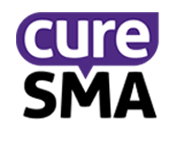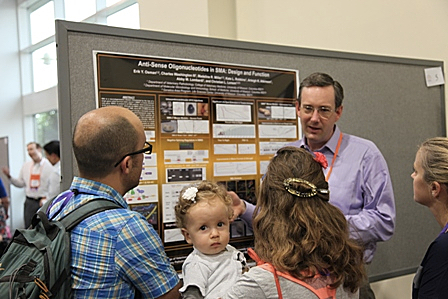Promising Study of SMA Therapy in Mice Targets ‘Backup Gene’ SMN2
Written by |

 Cure SMA-funded researcher Dr. Christian L. Lorson and his colleagues have published a paper in the journal Molecular Therapy describing a promising therapeutic prospect in a mouse model with severe spinal muscular atrophy (SMA).
Cure SMA-funded researcher Dr. Christian L. Lorson and his colleagues have published a paper in the journal Molecular Therapy describing a promising therapeutic prospect in a mouse model with severe spinal muscular atrophy (SMA).
The article, “Optimization of Morpholino Antisense Oligonucleotides Targeting the Intronic Repressor Element1 in Spinal Muscular Atrophy,” is authored by Lorson and a team of researchers at the University of Missouri in Columbia with collaborators at the University of Southern California, Los Angeles, and the the Medical College of Wisconsin at Milwaukee.
The Lorson lab focuses on SMA, a disorder that develops in children who are missing a specific gene called SMN1. It affects 1 in 6,000 live births and is the leading genetic cause of infantile death. Due to a genetic mutation in the SMN1 gene, people with SMA are unable to produce adequate levels of survival motor neuron protein (SMN protein).
The research project’s objective was to investigate strategies for increasing SMN protein production in SMN2, the SMA “backup gene” that is nearly identical to SMN1. The scientists note that everyone with SMA also has at least one copy of SMN2, which produces functional SMN protein, albeit in small amounts. A compound developed by Lorson targets SMN2 and effectively stimulates the SMN2 gene to increase production of the correct SMN protein.
In the Molecular Therapy paper, the investigators describe how a splice-switching Morpholino antisense oligonucleotide (ASO) sequence screened for efficacy in a mouse model consistently increased the lifespan of severe SMA mice after a single intracerebroventricular injection in the central nervous system. It exhibited a strong dose-response and demonstrated excellent target engagement by partially reversing a pathogenic SMN2 splicing event.
They conclude that “Morpholino modified ASOs are effective in modifying SMN2 splicing and have the potential for future spinal muscular atrophy clinical applications.”
“Our current treatment helps the body create a backup mechanism to combat the disease and extends survival in mice with SMA from just 13 days to a little over five months after only one injection at birth,” Lorson said in a pess release. “This treatment helps produce the right form of SMN, the one that was only produced at very low levels before.”
Lorson and Dr. Arthur Burghes of Ohio State University at Columbus (who was not one of the authors of the Molecular Therapy paper) jointly received a $150,000 grant from Cure SMA in 2013 to fund research into this potential treatment approach. On his Ohio State website, Burghes says his lab focuses on unraveling the molecular biology of SMA. Researchers have developed a mouse model of SMA demonstrating that a high copy number of the SMN2 gene can rescue the SMA mouse, and are using this animal model to understand why motor neurons are affected, with the objective to develop treatments for SMA.
Earlier this year, Cure SMA awarded Burghes another $140,000 for funding his project: “Defining the contribution of RNP assembly pathways to the SMA phenotype.” That research will focus on the cellular function of survival motor neuron (SMN) proteins in the hopes of learning more about how SMN functions in cells to help them function correctly.
“Cure SMA was instrumental in providing the initial funding for this project,” Lorson said. “At the time, our lab knew that optimization of the sequence for our ASO was important, however, funding was not available to develop or test these new compounds. Cure SMA provided funding that allowed us to identify the optimized E1 ASO compound, screening a new panel of sequences, leading to the identification of our current lead candidate that can extend survival in SMA mice nearly 10-fold.”
Additionally, this work is exciting because it brings another type of chemistry to the fight against SMA Morpholino chemistry. We are excited to continue to push this work closer to the clinic and we are grateful for the early stage funding received by Cure SMA and the families that support the SMA community,” Lorson said.
Cure SMA is a non-profit dedicated to advocacy and funding research for the treatment and cure of SMA and providing support to families living with SMA.
Lorson presenting at one of Cure SMA’s Family Friendly Research Poster Sessions. Photo courtesy Cure SMA
“We’re very excited about these results and the continued progress of this program,” said Jill Jarecki, PhD, Cure SMA’s chief scientific officer. “We know also that the entire SMA community shares in our excitement at seeing another promising treatment continue to move forward. Dr. Lorson’s project is part of a multiprong strategy to attack SMA from all sides, looking at treatments that address the underlying genetics, including the SMN2 gene, and at treatments that protect the muscles and nerves. We eventually hope that these drugs can be used in combination to provide the best possible therapeutic effect.”
Lorson acknowledges the unlikelihood of a single compound addressing the full gamut of SMA symptoms, but suggests that by combining therapies currently the subject of research, a better prognosis for an SMA treatment or cure could be on the horizon. If additional studies over the next few years are successful in building on the the promise of early-stage results of this research, these compounds may advance to human clinical trials with hope of developing new treatments for SMA.







